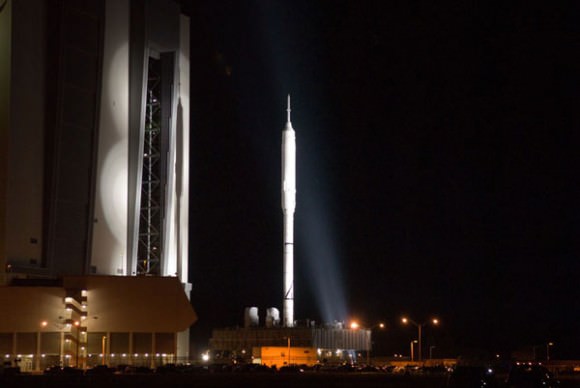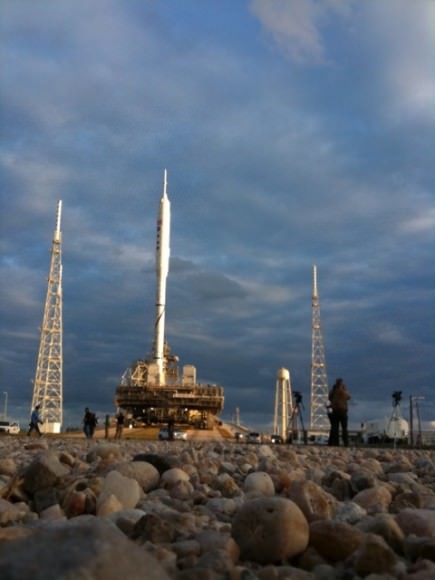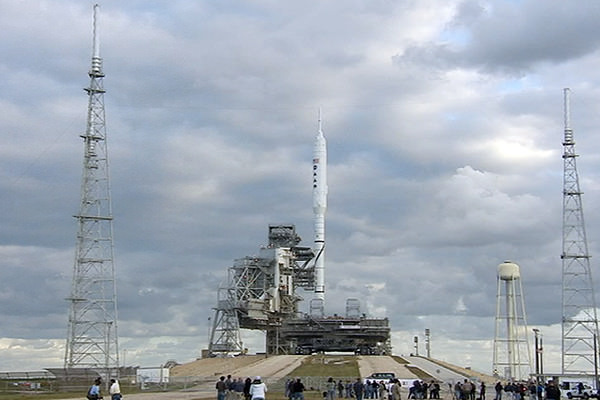[/caption]
“The Stick” made it out to launchpad 39B without falling over. I have to admit, NASA’s new rocket looked tall, super-skinny and pointy (as Dr. Brian Cox described it), as it rolled out on the crawler transporter. Somehow, it seems the Ares I-X should be wider. It’s definitely tall — at 100 meters (327 feet,) it is 43 meters (143 feet) taller than the space shuttle. But appearances aside, this is an historic occasion. For the first time in more than a quarter century, a new vehicle is sitting out at the launchpad at Kennedy Space Center in Florida.
More pictures below:

The Ares I-X flight test vehicle arrived at the pad at approximately 7:45 a.m. EDT Tuesday. The crawler-transporter left Kennedy’s Vehicle Assembly Building at 1:39 a.m., traveling less than 1 mph during the 4.2-mile journey. The rocket was secured “hard down” on the launch pad at 9:17 a.m.
The test flight of the Ares I-X rocket is scheduled to launch at 8 a.m. on Oct. 27. This test flight will provide NASA an opportunity to test and prove hardware, models, facilities and ground operations associated with the Ares I launch vehicle. Mission managers will finalize the launch date at a flight readiness review on October 23.
And in case you aren’t familiar with what the Ares I-X is for, the test flight will check out this un-crewed, modified Ares I configuration with a sub-orbital development test that will launch the rocket 43 km (28 miles) in altitude. This is the first developmental flight test of the Constellation Program, which includes the Ares I and V rockets, Orion and the Altair lunar lander.
Unless it all gets axed. The Augustine Report comes out on October 22.

For more great images of Ares I-X, checkout Robert Pearlman’s collection of rollout pics over at collectSPACE, or Spaceflightnow.com’s gallery of Ares I-X images from this morning.


Wow – that thing looks top heavy, but I guess (hope) NASA knows what they are doing!
As ugly as Saturn-V was beautiful…
“Unless it all gets axed. The Augustine Report comes out on October 22. ”
Man it must be depressing for the team to work under these conditions. It must be hard enough to build one of these things anyway, and stay optimistic through all of the inevitable trials and tribulations and false starts and frustrations, even with the full support of the public, the pollies and the agency. It must be absolutely miserable to realise that you are working on a project that has a damn good chance of getting canned, has little public support, has huge external political pressure placed on it not just in the direction of getting it done within budget, but in about a million different conflicting directions, etc.
I can’t imagine they’d be able to give their best concerted effort to make this vehicle a reality under those circumstances.
Okay… now tell me again.. how many tons of noxious chemicals will this ‘bird’ spew into the upper atmosphere each flight?
“In contrast, today’s solid-fuel rockets use solid materials such as perchlorate compounds as oxidizers, and the fuel and oxidizer are mixed together before being packed into the rocket. In other words, the fuel is “charged” and ready to explode … not a friendly material to work with.
It’s not friendly for the environment either. When today’s solid fuels burn, they produce the acidic compound hydrogen chloride and other noxious chemicals. When it rains, these compounds find their way into lakes and soils, and the increased acidity can harm plant and animal life.”
Sweet… high speed cryo-turbines are a lot more expensive.. initially…. but in the long run may prove to be cheaper – environmentally speaking.
I guess I take the long view–like billions of years. We speak as if our future is guaranteed. Like we have the luxury of relaxing on top of the food pyramid. We made it, the pressure is off. Not me. IMHO, we need to take the gloves off, scream bloody murder, and put the foot to the floor. Technology, not Utopian Green Dreams will assure our survival. Politics and political Gubmint is the enemy.
We need to get beyond Dumbocracy and empower individuals, not scum of the earth opportunists masquerading as the epitome of human evolution.
Uncle Dougie.
“Technology, not Utopian Green Dreams will assure our survival.”
A cautious and well thought out approach to living on this planet will assure our survival – technology is nothing more than a tool. In fact, its a bloody great tool, but on the flipside – how many times has technology facilitated our being brought to the brink of catastrophe now? Cuban missile crisis anybody? Coming within a whisker of complete global financial meltdown anyone?
Humans have developed technology far more rapidly than our meagre brains have evolved to get a handle on using it sensibly. We’re more or less still cavemen running around, bent over and jammed by our primal instincts. The only thing is, now we have technology, the opportunities and consequences of our decision making are amplified greatly. This means we have tremendous potential to do great things. Unfortunately, human history tends to show that we balls things up more often than not.
To quote Feynman quoting some monk “To every man is given the keys to heaven. The same key opens the gates to hell.” So yes, technology is of great value. But it sure as hell won’t save us from ourselves if we just blindly jam the accelerator down and see what happens.
@ Aqua and Astrofriend:
Absolutly right!
Technology also has a manufacturing and run-time costs and impact on people and the environment. It’s benefits must outweigh these costs in order to be beneficial. This is a simplistic response to the simplistic “Technology, not Utopian Green Dreams will assure our survival.”
The design and usage of technology must be well thought out. Creation of solar cells and wind turbines takes energy and materials to create. Their benefits must outweigh these during life of their usage in order to have a large net benefit.
Look at gasoline. It’s convenient to use and can get you across the entire United States, but half the energy is lost as heat, takes energy to drive it to a nearby gas station, takes energy to refine and pull it out of the ground. Not to mention the wars that have been fought over it.